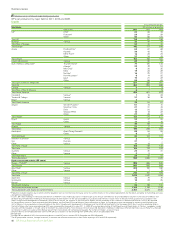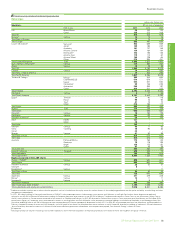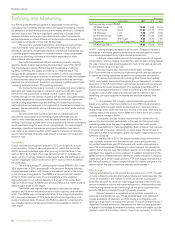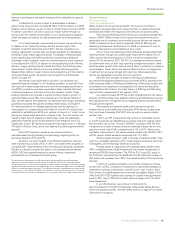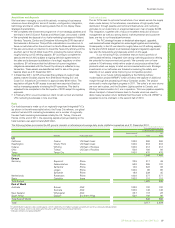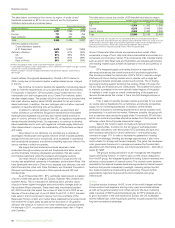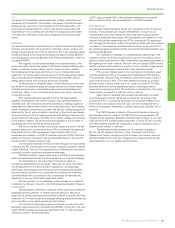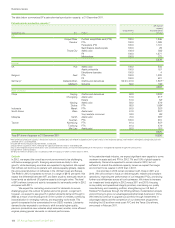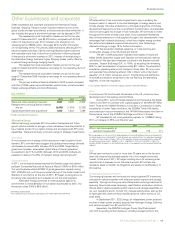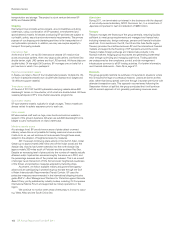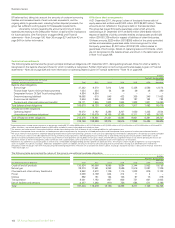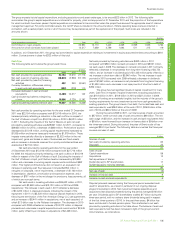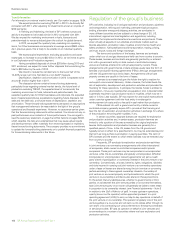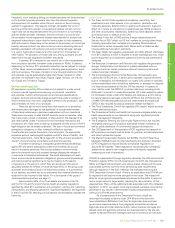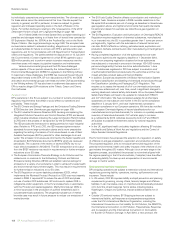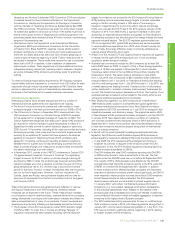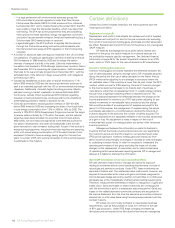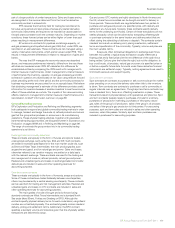BP 2011 Annual Report Download - page 104
Download and view the complete annual report
Please find page 104 of the 2011 BP annual report below. You can navigate through the pages in the report by either clicking on the pages listed below, or by using the keyword search tool below to find specific information within the annual report.
102 BP Annual Report and Form 20-F 2011
Business review
transportation and storage. The project is a joint venture between BP
(40%) and Masdar (60%).
Shipping
We transport our products across oceans, around coastlines and along
waterways, using a combination of BP-operated, time-chartered and
spot-chartered vessels. All vessels conducting BP activities are subject to
our health, safety, security and environmental requirements. The primary
purpose of our shipping and chartering activities is the transportation of
our hydrocarbon products. In addition, we may use surplus capacity to
transport third-party products.
International fleet
At the end of 2011, we had 53 international vessels (37 medium-size
crude and product carriers, three very large crude carriers, one North Sea
shuttle tanker, eight LNG carriers and four LPG carriers). All these ships are
double-hulled. Of the eight LNG carriers, BP manages one on behalf of a
joint venture in which it is a participant.
Regional and specialist vessels
In Alaska, we retain a fleet of four double-hulled vessels. Outside the US,
we had 14 specialist vessels (two double-hulled lubricants oil barges and
12 offshore support vessels).
Time-charter vessels
At the end of 2011 BP had 93 hydrocarbon-carrying vessels above 600
deadweight tonnes on time-charter, all of which are double-hulled. All these
vessels participate in BP’s time-charter assurance programme.
Spot-charter vessels
BP spot-charters vessels, typically for single voyages. These vessels are
always vetted for safety assurance prior to each use.
Other vessels
BP uses various craft such as tugs, crew boats and seismic vessels in
support of the group’s business. We also use sub-600 deadweight tonne
barges to carry hydrocarbons on inland waterways.
Maritime security issues
At a strategic level, BP avoids known areas of pirate attack or armed
robbery; where this is not possible for trading reasons and we consider
it safe to do so, we will continue to trade vessels through these areas,
subject to the adoption of heightened security measures.
2011 has seen continuing pirate activity in the Gulf of Aden, Indian
Ocean (up to approximately 200 miles west of the Indian coast) and the
Arabian Sea. Activity has further extended into the north Arabian Sea
(approximately 200 miles south of Pakistan) and the southern Red Sea.
Despite an increasing level of piracy activity the number of vessels actually
attacked and/or hijacked has remained roughly the same as in 2010, and
the percentage success rate of the pirates has reduced. This is as a result
of stronger naval intervention off the Somali coast, heightened awareness
of the threat, and protective measures adopted by transiting ships.
At present, we follow available military and government agency
advice and are participating in protective group transits through the Gulf
of Aden Internationally Recommended Transit Corridor. BP uses the
protective measures recommended in the international shipping industry
guide BMP 4 – Best Management Practices for Protection against Somalia
Based Piracy, jointly published by industry bodies, including Oil Companies
International Marine Forum and supported by military operations in the
region.
We continue to monitor other areas where piracy is known to occur
e.g. West Africa and the South China Sea.
Aluminium
During 2011, we terminated our interest in this business with the disposal
of our wholly-owned subsidiary, ARCO Aluminum Inc., to a consortium of
Japanese companies for cash consideration of $680 million.
Treasury
Treasury manages the financing of the group centrally, ensuring liquidity
sufficient to meet group requirements and manages key financial risks
including interest rate, foreign exchange, pension and financial institution
credit risk. From locations in the UK, the US and the Asia-Pacific region,
Treasury provides the interface between BP and the international financial
markets and supports the financing of BP’s projects around the world.
Treasury trades foreign exchange and interest rate products in the
financial markets, hedging group exposures and generating incremental
value through optimizing and managing cash flows. Trading activities
are underpinned by the compliance, control, and risk management
infrastructure common to all BP trading activities. For further information,
see Financial statements – Note 26 on page 217.
Insurance
The group generally restricts its purchase of insurance to situations where
this is required for legal or contractual reasons. Losses are borne as they
arise, rather than being spread over time through insurance premiums with
attendant transaction costs. This approach was reviewed following the
Deepwater Horizon oil spill but the group concluded that it will continue
with its current approach of not generally purchasing insurance cover.


